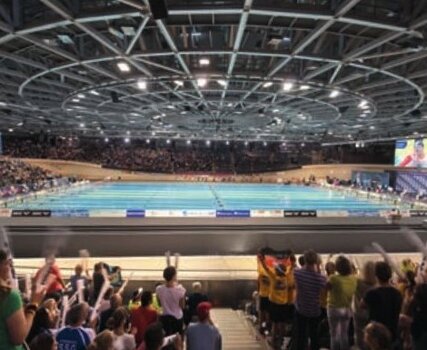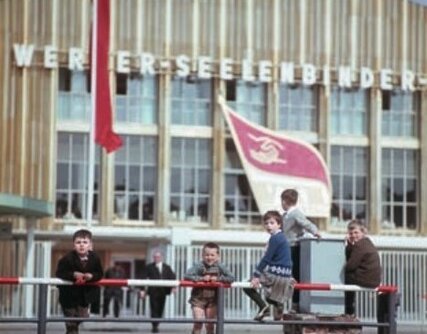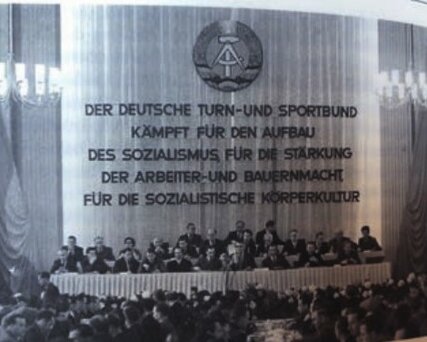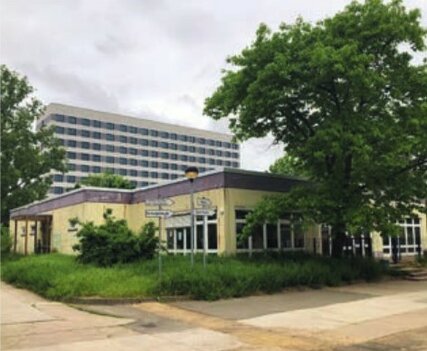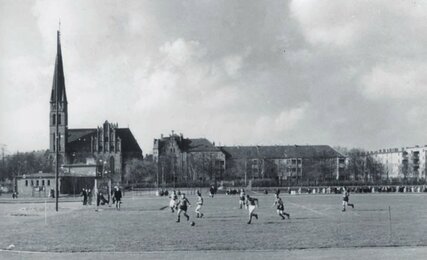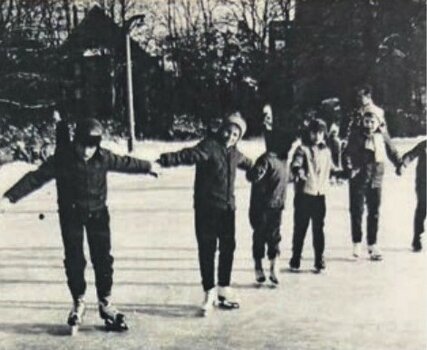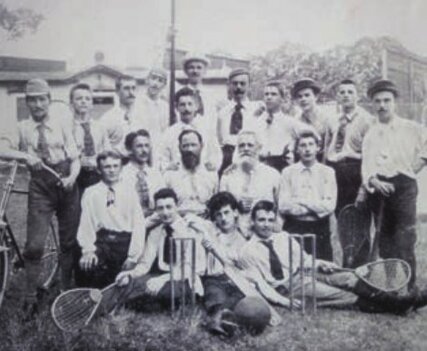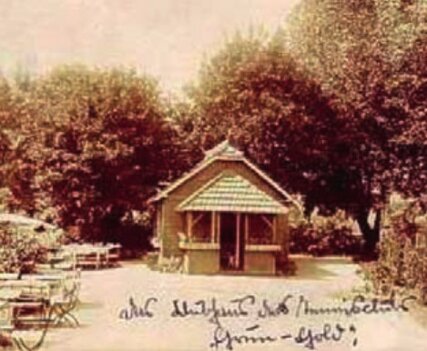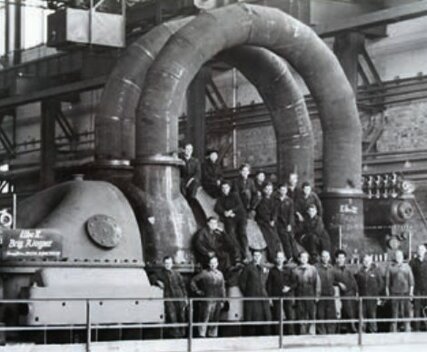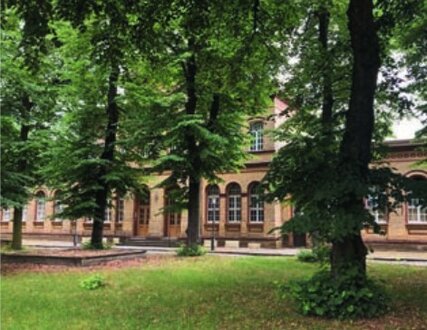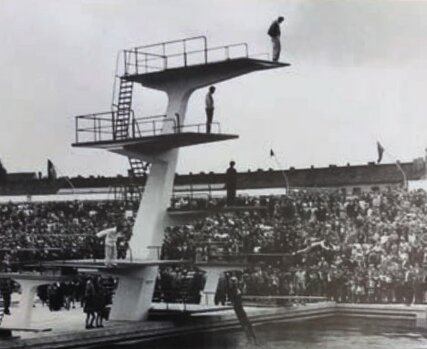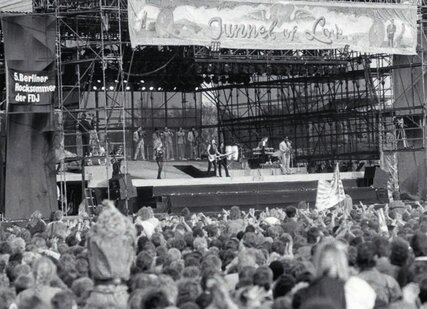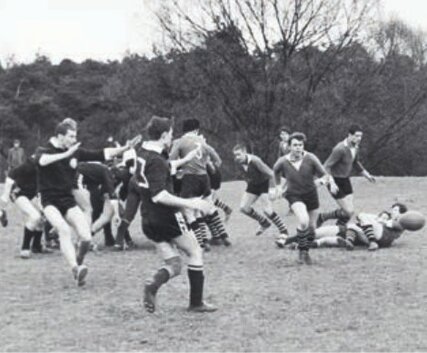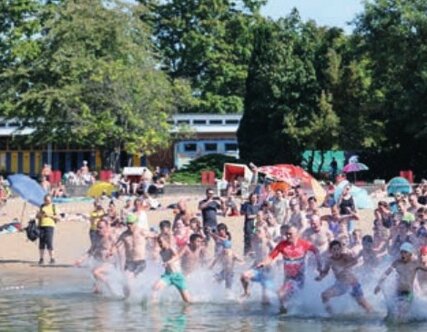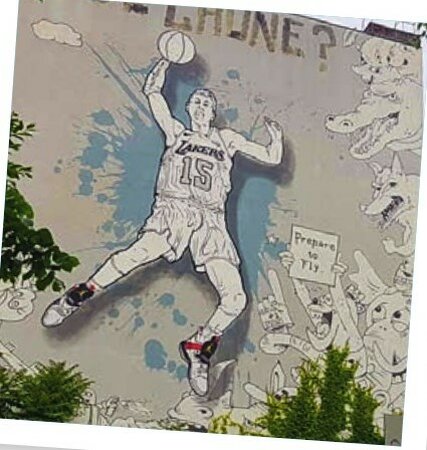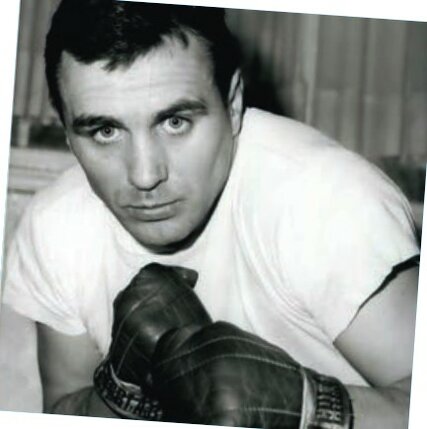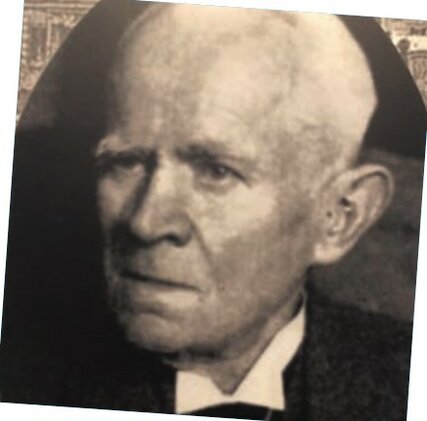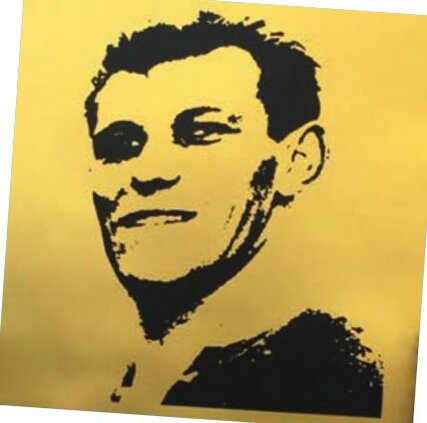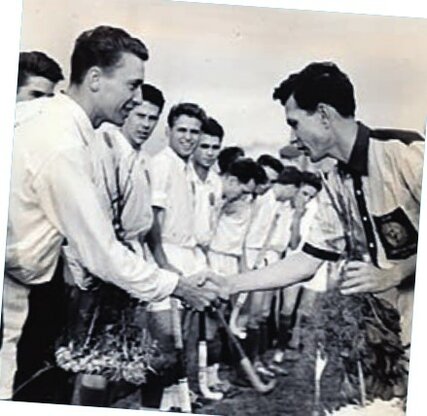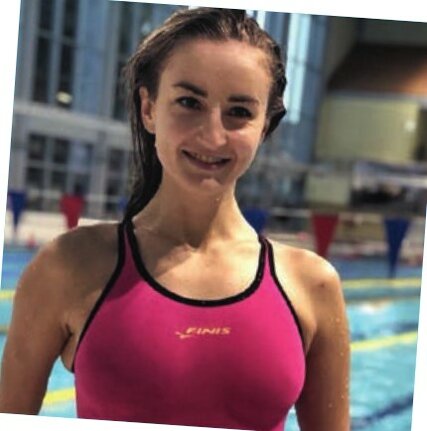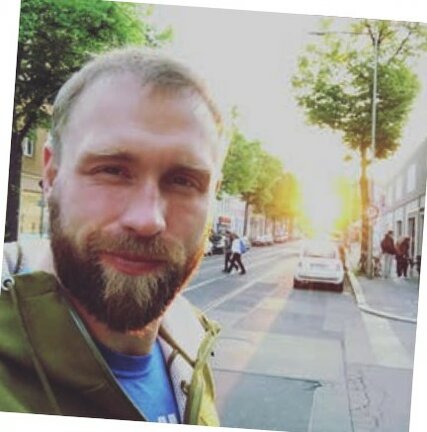Pankow Sport Stories
Sporting Tales of Pankow: A Journey Through Its Athletic Past and Present
Sports and sports venues have been an integral part of Pankow’s history since the late 19th century. From the fi rst football clubs in the 1890s to historic grand events at Friedrich-Ludwig-Jahn Sports Park, the former Weißensee Velodrome, and Werner-Seelenbinder- Halle, to internationally renowned sports events and athletes of today, the district’s sporting history is rich with highlights and significant figures.
The Pankow Tourism Association aims to bring this fascinating sporting history to life for both sports enthusiasts and local residents.
In addition to historical and modern sports venues, the brochure also features famous sports personalities from the district, bridging the gap to current sports stars. The brochure showcases the wide array of sports offerings and numerous opportunities available to district residents. Publicly accessible sports fields are included in the maps.
Experience Pankow’s rich sporting history and discover the diverse opportunities to get active yourself!
Brochure: PANKOW SPORT STORIES - Sporting Tales of Pankow: A Journey Through Its Athletic Past and Present - Download as PDF file
PLACES OF SPORTING HISTORY
1. Velodrom
Paul-Heyse-Straße 26, 10407 Berlin
The Velodrom, along with the Max-Schmeling-Halle and the swimming and diving halls in the Europapark (SSE), was planned as part of Berlin’s bid for the 2000 Olympic Games. Despite Sydney winning the bid, they were designed and built as multi-purpose arenas. The Velodrom opened in 1997 with the inaugural day of the 86th Berlin Six-Day Race. It is characterized by its circular shape, unique steel roof structure, and underground embedding and it accommodates 12,000 visitors. Since its opening, it has been the hub of cycling in Berlin.
The Six-Day Race began in Berlin in 1909 and has been held at the Velodrom since 1997. Since the winter of 2016/17, the Berlin Six-Day Race has been part of the Six Day Series. The Berlin “Sixdays” had their beginnings in the “Roaring Twenties”. They were not only a sporting but also a social event. Wellknown artists and later sports celebrities, including successful boxers like Max Schmeling, Bubi Scholz, or Wladimir Klitschko, didn’t miss the opportunity to perform in public and even kick off the event.
However, the Velodrom is not just a cycling track but also one of Berlin’s largest event halls. Renowned artists like Madonna, Muse, and Rihanna have already graced the stage of the Velodrom.
2. Former Werner-Seelenbinder-Halle
Paul-Heyse-Straße 26, 10407 Berlin
The “Werner-Seelenbinder-Halle”, built in East Berlin in 1950, was a significant sports and event hall in the German Democratic Republic. Originally constructed as a wholesale meat market hall, it was converted into an event hall and opened in 1950. Located at Paul-Heyse-Straße 26 in Prenzlauer Berg, it was demolished in 1992. Today, the Velodrom and the Swimming and Diving Hall in the Europasportpark stand on the site. The hall hosted numerous competitions, including indoor handball world championships, boxing matches, weightlifting tournaments, volleyball games, figure skating, ice hockey tournaments, and cycling races. A 171-meter-long cycling track was installed in 1966/67 and used annually for winter track races from December to February. The hall also served as a training venue for TSC Berlin, featuring a short track for speed skating and an ice hockey rink. In addition to sporting events, concerts were held here, featuring prominent artists such as Peter Maffay, Solomon Burke, James Brown, and Kool & the Gang. After reunification, the hall remained an important venue. In 1992, it was demolished as part of Berlin’s Olympic planning to make way for new sports facilities.
3. DTSB – German Gymnastics and Sports Federation of the GDR
Storkower Straße 120, 10407 Berlin
The German Gymnastics and Sports Federation (DTSB) was founded on April 27–28, 1957, as the last mass organization of the GDR, replacing the German Sports Committee (DS) at that time. It took over tasks from the State Committee for Physical Culture and Sport and was directly led by the Central Committee (ZK) of the SED. The sports previously organized as sections were transformed into sports associations, such as the German Football Association (DFV) from the football section. The DTSB was divided into a total of 15 district organizations, which were further subdivided at the county, city, and city district levels. The DTSB primarily promoted competitive sports, with grassroots sports serving as talent scouting. With a well-thought-out program of scouting and selection, school children were tested for their competitive sports talents. Children’s and youth sports schools and the children’s and youth Spartakiads, held since 1965, served the promotion of young sports talents. The GDR achieved significant sporting successes, especially at the Olympic Games. The GDR participated for the first time in the 1968 Olympics in Mexico. In total, GDR athletes won 203 gold medals and a total of 755 medals at the Olympic Games.
Manfred Ewald – president of the DTSB from 1961 to 1988 – was significantly involved in the establishment of the centrally controlled competitive sports system, which focused on medal-winning sports. He was convicted of aiding and abetting bodily harm in 2000 and died in 2002. Until 1989, the GDR had over 3.7 million members in sports associations. The DTSB employed more than 10,000 people, including about 4,200 coaches. With the fall of the Berlin Wall, the DTSB lost its signifi cance and dissolved in 1990. The former headquarters of the DTSB is located in Storkower Straße, where today the Employment Office VII Berlin is located.
4. TSC Berlin’s Performance Center – today Paul Heyse Sports Complex
Children and Youth Sports School “Ernst Grube” (later Coubertin Gymnasium),
Paul-Heyse-Straße 25, 10407 Berlin
Berlin TSC was formed in 1963 from the merger of three clubs and experienced a glorious era. With 21 sports, the club established itself as a significant institution in Berlin sports. Olympic champions like Lucke/Bothe in rowing and three-time European Cup winners in handball shaped this period. In 1973, the Children’s and Youth Sports School (KJS) “Ernst Grube” was completed in Paul-Heyse-Straße. A new sports complex with a multipurpose hall, an administrative building, a running hall, and throwing and running tracks was built on the grounds north of the Werner-Seelenbinder-Halle. In 1974, a new boarding school building was added, used by the KJS and TSC. Many sports were outsourced from the club after the 1968 Olympics. The football club 1. FC Union Berlin took over the footballers of TSC Berlin in 1966. In the late eighties, young talents like Eric Zabel and Jens Voigt in cycling, and Monique Garbrecht in speed skating, made themselves known. The training facilities of TSC were located in various locations in Pankow, including the Weißensee Velodrome, the stadium in Buschallee (tennis), the Kissingen Sports Ground (handball), the Friedrich-Ludwig-Jahn Sports Park (athletics), and the Werner-Seelenbinder-Halle (figure skating and ice hockey). After reunification, in 1992, five athletes from the club represented Germany at the Olympic Games in Albertville and Barcelona, with Jacquelin Boerner winning Olympic gold and Monique Garbrecht winning a bronze medal.
Today, the Paul-Heyse-Straße Sports Complex (PHS) is an important training and competition venue for elite athletes, with three federal training centers and six state training centers. Covering 70,000 square meters, it off ers various sports halls and fi elds. In addition to TSC, around 30 sports clubs offer diverse sports activities at different performance levels here.
5. Friedrich-Ludwig-Jahn-Stadium
(formerly sports ground “By the Lonely Poplar”), Cantianstraße 24, 10437 Berlin
Popularly known as the “Exer”, the stadium was used as a parade ground for a Guard Regiment by the Prussian Army since 1825. Its landmark was the “Solitary Poplar”. On March 26, 1848, the first popular assembly of the rebellious Berliners during the Revolution of 1848 took place at the far-standing black poplar. Up to 20,000 people demanded universal suff rage, a 12-hour workday, minimum wages, and staterun education instead of private or denominational schools. The “Lonely Poplar” on Topsstraße was felled in 1968. By the end of the 19th century, the army had abandoned the “Exer” as a drill ground, now surrounded by residential buildings. On April 18, 1892, the Berlin selection of the German Football and Cricket Association played against the Dresden English Football Club here. The legendary match is considered the first heavily promoted football match with a paying audience in Germany. Shortly thereafter, the newly founded club Hertha BSC used the ground as its first venue until 1904. The Berlin football club was founded in 1892 in a pub in the nearby Zionskirchstraße as “Hertha 92”. Today, Hertha BSC is based at the Olympic Stadium in Charlottenburg. Tennis Borussia Berlin also played here from 1903. In 1912, the city of Berlin purchased most of the area and transformed it into a sports and gaming facility in 1913. On the occasion of the World Festival of Youth and Students in 1951, the facility was expanded into the “Berliner Sportpark”. On 22 hectares, a football and athletics stadium with 20,000 seats and several game, training, and competition venues were built.
In 1952, the East Berlin Magistrate named the sports park after the “gymnastics father” Friedrich Ludwig Jahn. In addition to signifi cant sports events such as the finish of the International Peace Race in 1953, the first international football matches of the GDR took place here. The last major game was on March 21, 1990, the 2–0 victory of the GDR national football team against the USA, the only home game in the now reunited Berlin. Today, the facilities are to be rebuilt. The redesign aims to create Berlin’s first inclusive and intercultural sports park.
6. Max-Schmeling-Halle
Am Falkplatz 1, 10437 Berlin
The Max-Schmeling-Halle in Prenzlauer Berg, opened in 1996, is one of Berlin’s largest event halls with a capacity of up to 11,900 spectators. It was planned as a boxing arena as part of Berlin’s bid for the 2000 Olympic Games and is named after boxing world champion Max Schmeling. Operated by Velomax Berlin Hallenbetriebs GmbH, the hall serves as the home venue for the BR Volleys and the Fuechse Berlin, as well as the site of the State Performance Center for DanceSport.
In addition to sports events, the hall is used for concerts, trade fairs, shows, and conferences. From 1997 to 2022, over 1,700 sports events and 400 concerts took place. Stars like Madonna and Robbie Williams have performed here. The hall is also committed to environmental sustainability: since 2016, the Stadtbiene association has operated a beehive on the roof, and since 2019, sheep have regularly grazed there. The Max-Schmeling-Halle is part of the Friedrich-Ludwig-Jahn-Sportpark and borders the Mauerpark. Its circular, green roof symbolizes a Green Bridge between East and West Berlin. In 2002, it received the IOC/IAKS Award for Sports Facility Architecture. The roof is equipped with a large solar power system that produces 220 MWh of electricity annually. For its ecological orientation, the hall was certified by Green Globe in 2011.
7. Kissingen Stadium
Forchheimer Straße 15, 13189 Berlin
The Kissingen Stadium, home of FSV Fortuna, is located in the Kissingen district and has a rich history. As early as 1928, there was a football field and a playground here. After the battles in Pankow in 1945, the area was temporarily occupied by the Red Army. During the World Festival of Youth and Students in 1951, the stadium acquired its current form with 8,000 standing places and natural grass. In addition to Fortuna, BSV Heinersdorf also plays here. In the 1980s, BSG Bergmann-Borsig held their matches in the stadium, even in the GDR league. Fortuna was founded in 1945 as SG Pankow South and officially registered as FSV Fortuna Pankow e.V. in 1946. Until 1950, the club participated in the regular competitions of Greater Berlin and was particularly successful in the Berlin Cup. 1950 marked a turning point in Berlin football when the split between East and West changed the game. Fortuna was integrated into the District League Group B. In 1956, it was renamed BSG Motor Pankow.
After reunification in 1990, the club reverted to FSV Fortuna Pankow. Today, Fortuna is active in Berlin’s sports scene with various teams. The Kissingen Stadium not only off ers the opportunity to watch Fortuna’s matches but also to get involved oneself, as the sports ground is open daily and equipped with numerous calisthenics facilities.
8. Former Sports Ground Pfeilstraße
Pfeilstraße, 13156 Berlin
The former Pfeilstraße sports ground was located in the “Forstviertel”, between the present-day Grabbeallee, Pankebruecke, and Zingergraben. The area was characterized by the “Schoenhauser spruces” and belonged to the forest district. From 1904, the area was divided into plots, and the streets were named after forestry. Friedrich Wilhelm Leopold Pfeil, the director of the Berlin Forestry Academy, gave his name to Pfeilstraße. The construction of small villas began after World War I. A sports facility of 12,542 m² was already designated on the map from 1925. The space was used by Pankow workers’ associations.
On January 20, 1946, the first Greater Berlin Ice Show took place here. Many Pankow residents used the ice surface in the winter months. It is said that Walter Ulbricht, the GDR statesman who lived in the nearby Pankower Majakowskiring until he moved to Wandlitz, also skated here. In 2007, the facility was sold, and the proceeds were used to renovate the sports ground in Pichelswerder Straße.
9. Walter Husemann Sports Ground
Pichelswerder Straße, 13156 Berlin
In the early 1920s, SC Pankow 08, SC Union 1911 Pankow, and BFC Nordiska 1913 were playing football here at Pichelswerder Straße. The latter contested the fi nal match for the East German Championship of the Workers’ Gymnastics and Sports Federation here on May 22, 1921. Nordiska won the game against Breslau Sued 1919 in front of 1500 spectators. Today, Borussia Pankow 1960 e.V. is domiciled here on the pitch. The former clay surface is now covered with artifi cial turf. Since the GDR era, the sports fi eld has been named after the Pankow anti-fascist Walter Husemann.
10. Paul Zobel Sports Ground – Home Ground of VfB Einheit zu Pankow
Hermann-Hesse-Straße 80, 13156 Berlin
VfB Einheit zu Pankow 1893 e.V. was founded on September 18, 1893, by 26 sports enthusiasts at the Hertling restaurant. The club experienced rapid growth and was a founding member of the German Football Association (DFB) in 1900. Originally, the club offered sports such as gymnastics, cricket, fencing, cycling, and football. An ice hockey team existed from 1897 to 1901. Initially, the club trained on the playing field in front of “Schloss Schoenholz” and later on tennis courts in Schoenholzer Heide. Due to the growing number of members, the football department moved to a new location at the corner of Mendelstraße and Stiftsweg in 1910. In 1929, the club had to relocate again, and in 1950, it found its new sports ground at today’s Hermann-Hesse-Straße, which was named the Paul Zobel Ground. Prominent figures in the club included the Manning brothers. Gustav Manning played a significant role in the founding of FC Bayern Munich and the DFB. Fred Manning represented VfB Pankow at the founding of the DFB. Three club members, all named Willy, played internationally for the DFB.
World War II brought the club’s operations to a halt, and in 1944, the sports facilities were destroyed by bombs. After the war, the club was dissolved in 1945, and sports continued under the name SG Pankow Nord. In 1948, the club was allowed to resume the name VfB Pankow. Political developments in 1950 led to the club being withdrawn from the Berlin City League and integrated into the GDR Premier League. In 1951, the club merged with SV Einheit Pankow to form SG Einheit Pankow. Dissatisfied members founded a new club named VfB zu Pankow 1893 in West Berlin. The original club in the GDR produced two East German national players: Horst Assmy and Karl-Heinz Spickenagel. On May 14, 1991, the East and West clubs merged to form VfB Einheit zu Pankow 1893 e.V.
11. Tennis in Pankow / spok Tennis and Sports Facility
Nordendstraße 56, 13156 Berlin
In the GDR, tennis was considered elitist and wasn’t even part of the Olympic program until 1988. Therefore, there were only a few tennis clubs in East Berlin. One of the oldest in Pankow is TC Gruen Gold Pankow. It was founded in 1913 as Gruen Gold Pankow and underwent a varied history thereafter. Furthermore, there was the tennis department of SG Bergmann Borsig, founded in 1951, and the tennis club SV Berliner Brauereien e.V., founded in 1953. The Humboldt-Tennis-Club e.V. was also founded in 1949 and moved to Pichelswerder Straße 7 in 1958. Their 1st women’s team became GDR champions several times.
The modern tennis and sports facility of spok on Nordendstraße was formerly called Treskowsportplatz. The place belonged to Tennis Borussia Berlin in the 1920s and 30s, which in turn belonged to the founding members of the Berlin Lawn Tennis Association. In April 1903, the club rented two courts at Bahnhof Zoo; some relocations later, they played on three courts in Schlosspark Niederschoenhausen amid a harmonious atmosphere (from 1912 to 1945). After being expropriated by the Nazis, not only sports were practiced here on these courts; the Hitler Youth used it for training and marching. During the GDR era, the Diplomatic Corps exclusively used the place for tennis. After reunification, spok gGmbH took over the area in 1992, made it accessible to the public, and now off ers tennis, badminton, fi tness, beach volleyball, table tennis, football, basketball, and more.
12. PankowPark / BSG Wilhelmsruh Bergmann Borsig
Industrial Area, Heinz-Brandt-Straße, 13158 Berlin
In spring 1946, handball players from Reinickendorf, Rosenthal, and Wilhelmsruh founded the sports community (later BSG) Wilhelmsruh. Handball was the first section, with training taking place at the cultural center of the VEB (Volkseigener Betrieb = “Publicly Owned Enterprise”) Bergmann-Borsig. By the end of 1950, the sports ground “Am Ehrenmal” became usable for the BSG. The gymnastics section was also established in 1946 and was one of the founding sections. It grew to over 100 members by the end of the 1950s, and today, 230 members train there in 14 groups. New sports were introduced, including tennis, hockey, football, archery, table tennis, and wrestling. The BSG achieved great success in sports. The men’s handball team became East Berlin champions in 1962, and the women’s volleyball team became East Berlin champions in 1974. Gerda Riewe became East German doubles tennis champion and played in the highest-level DDR league. The football section was founded in 1956 as Motor Wilhelmsruh with 40 members and developed successfully within BSG Bergmann-Borsig until 1990, with promotion to the GDR league. Stefan Beinlich, an apprentice at the vocational school, played in the GDR league and transferred to Aston Villa at the age of 19, later to Hansa Rostock in the German Premier League and then to other Premier Clubs. The current competitive flagship is archery, with Olympic medals in Atlanta (1996) and Sydney (2000) and numerous titles at German championships.
13. Marksmanship club Schoenholzer Heide
Hermann-Hesse-Straße 82, 13156 Berlin
Berlin’s oldest, the “Schuetzenhaus” (shooting lodge) on Hermann-Hesse-Straße, was long the home of the marksmen’s guild Berlin, founded in 1433 as protection against marauding knights. In the early 15th century, the Quitzow brothers created insecurity in the Margraviate of Brandenburg, leading to the storage of weapons in every household. Wealthy citizens such as councilors, merchants, and craftsmen formed protective brotherhoods, which led to the establishment of the marksmen’s guild. During the Thirty Years’ War, the guild practically dissolved as it could not resist the large armies. Under Friedrich Wilhelm (1640–1688), the guild was reinvigorated and celebrated marksmanship festivals. Until around 1880, members of the marksmen’s guild Berlin used used an area in Berlin-Mitte for their shooting exercises, but space became limited. The guild sold its city property for 1.3 million marks and acquired a 270,000 square meter area, including the “Schloss Schoenholz” restaurant in Niederschoenhausen. In 1884, the new shooting lodge was inaugurated. The building features a flat roof, round-arched windows, and is symmetrically structured. A relief above the second floor depicts a hunting scene. The ground floor housed weapon rooms, a workshop, a conference room, and a beer dispensing room. Upstairs, there were two apartments. The guild established several shooting ranges with distances of 100, 175, and 300 meters. In Schoenholz, several marksmanship festivals and important shooting events like the Middle German Federal Shooting (1902 and 1910) were held. The Nazis restricted marksmanship and imposed a uniform statute, which the marksmen’s guild rejected.
The shooting lodge was destroyed in 1945 and confiscated by the GDR authorities in 1949. In 1952, the Society for Sport and Technology (GST) took over the shooting lodge and shooting ranges, conducting marksmanship events and Pankow marksmanship festivals. Today, the renovated shooting lodge is used by various clubs, but not by the former owners. The “Schuetzengilde Berlin von 1433 e.V.” now trains in Wilmersdorf.
14. Pankow Open-Air Swimming Pool
Wolfshagener Straße 91–93, 13187 Berlin
The Pankow Open-Air Swimming Pool was opened on September 8, 1979. The idea for the outdoor pool emerged in 1951, when the SED (the Socialist Unity Party of East Germany) called for Berlin to be cleared of rubble. In 1957, architects Walter Hinkefuss and Heinz Graff under were commissioned to design it, and on March 1, 1958, the first sod was turned by Prime Minister Otto Grotewohl. Half a million marks were raised through citizen donations, and 220,000 voluntary working hours were contributed. The outdoor pool was inaugurated on July 9, 1960. Since its opening, the pool area has expanded from initially 6.3 hectares to almost 15 hectares. The swimming hall, built in 1971 by architect Gunther Derdau, included a 25-meter swimming pool, a 12 x 8.5-meter non-swimmer pool, and a sauna.
In 1996, the swimming hall and adjacent outdoor pool were taken over by the Berlin Swimming Facilities. The outdoor pool was renovated in 2000 and reopened in 2001 as the Pankow Summer Pool. The pools are now made of metal rather than tiles. There is a 50-meter swimming pool, a paddling pool, a 4.5-meter deep diving pool, and a multifunctional pool with electrical installations and water features. New metal slides, including a high-speed slide, have been installed. The 10-meter diving tower, however, was reduced to 7.5 meters. The swimming hall, however, was not renovated and remained closed. Since 2018, the Berlin Senate and the Berlin Swimming Facilities have been planning to repurpose the former indoor pool site, including a new multifunctional pool, a primary school and a gymnasium.
15. Weißensee Velodrome (“Radrennbahn Weißensee”)
Rennbahnstraße 50, 13086 Berlin
The Rennbahnstraße received its name in 1878 when the Berlin Traber-Club built a horse racing track modeled after those in England. The first races took place on June 16 and 17, 1878, attracting nearly 12,000 visitors. In 1884, the Traberclub went bankrupt, but horse races continued until 1912. From 1918 to 1925, the site was used for filming monumental silent films. In the early 1950s, residents of Weißensee constructed a velodrome from rubble, which was inaugurated in 1955. The track measured 333 meters. The velodrome hosted sports competitions such as the Berlin Track Championships, the Great Easter Prize, the Golden Wheel of Berlin, and GDR Championships in track cycling. However, due to structural issues, the velodrome was soon abandoned. In the late 1980s, large concerts were held there, attracting tens of thousands of young people, including performances by Bruce Springsteen. Today, sports such as football, tennis, archery, and baseball are played here.
16. Stadium Buschallee
Hansastraße 182, 13088 Berlin
The Stadium Buschallee was built in the early 1920s in the Volkspark Fauler See and opened on August 25, 1923. In 1937, Hertha BSC defeated a selection from the Weißensee district in front of 8,000 spectators. From 1937, the stadium served as the home ground for the Weißenseer FC. On May 27, 1945, the first football matches in Berlin after World War II were played here and at the Lichtenberg Stadium. The SG Weißensee, later ASV Weißensee, Blau-Weiß Weißensee, and eventually BSG Einheit Weißensee primarily used the stadium. In the 1950s, the Hohenschoenhausen SC played their home matches here. In 1951, the stadium was renovated for the 3rd World Festival of Youth and equipped with benches. In 1956, it became one of the first stadiums in Germany to install floodlights. Today, the complex includes not only the stadium but also the Tennisstadion Buschallee and the sports hall complex Hansastraße. It serves as the home venue for the Weißenseer FC and Rugbyklub 03, Berlin’s largest rugby club. The RK03 emerged in 2003 from the rugby section of Post SV, whose history dates back to 1967. Today RK03 has over 430 members, about half of whom are juniors.
17. Orankesee / Pfeffersport e.V.
Gertrudstraße 7, 13053 Berlin
Pfeffersport association, active for over 30 years, is Berlin’s largest children’s, inclusion, and recreational sports club. Under the motto “Diversity in Motion”, the club focuses on inclusion, allowing everyone regardless of physical abilities, origin, age, gender or sexual identity to participate. The annual “Oranke Open Triathlon” is an inclusive sports event held at the Orankesee beach near the district border between Weißensee and Alt-Hohenschoenhausen. Here, anyone, from young to old, whether individually or in a relay, can participate, whether on foot or in a wheelchair. The spirit of sport and enthusiasm take precedence, and the event invites everyone to discover triathlon sports from a new perspective.
LOCAL SPORT HEROES
Moritz and Franz Wagner
Franz and Moritz Wagner are brothers who grew up in Schivelbeiner Straße in the district of Prenzlauer Berg. Raised in the environment of their father Axel Schulz, a former GDR national handball goalkeeper, and their mother Beate Wagner, a doctor and medical journalist, they have always been surrounded by support. Both attended Thomas-Mann Grundschule, and both started at Alba Berlin before older brother Moritz went to the University of Michigan in 2015 and later joined the NBA. Younger brother Franz followed him in 2019. They both currently play for the Orlando Magic and share a home in Florida. They became famous, at the latest, in 2023 when they, together with the German men’s basketball team, became world champions for the first time. The mural in Christburger Straße shows Victor Moritz Wagner (1997), in front of (his) basketball court.
Gustav Wilhelm Hermann „Bubi“ Scholz
Born April 12, 1930, in Choriner Straße 54, Prenzlauer Berg, to a blacksmith, Gustav “Bubi” Scholz grew up in modest circumstances. As a professional boxer, he achieved his greatest successes in the late 1950s and early 1960s, exclusively boxing as a pro, never as an amateur. Scholz was considered Germany’s most popular boxer, winning several international titles. He fought in 96 matches, losing only two by points. In 1951, he became German welterweight champion for the fi rst time, a title he defended twice. He changed weight classes twice, first to middleweight, then to light heavyweight.
Despite his successes, he later experienced a tragic downfall, marked by alcohol. In July 1984, he fatally shot his wife in a drunken state and was sentenced to prison. After his release, he remarried and died in August 2000 at the age of 70 from the eff ects of strokes and Alzheimer’s.
Franz John
Franz John, a native of Pankow, was a trained photographer and, at the age of 21, one of the founding members of VfB Einheit Pankow. Due to his profession, he moved to Munich in 1879 and joined MTV Munich 1879. After a dispute over the development of the football department, he co-founded FC Bayern Munich on February 27, 1900, with 10 other players and served as its first president until 1903. In 1903, he returned to Pankow and operated a photography studio at Kreuzstraße 16. From 1905 to 1907, he again served as the club president of VfB Pankow. Franz John died in isolation in Pankow in 1952. A commemorative stone was erected on his now dilapidated grave in Pritzwalk on the 100th anniversary of the founding of FC Bayern Munich, initiated by fans.
Helmut Faeder
Helmut Faeder was born on July 3, 1935, in Buchholz and began his football career in 1946 at today’s SV Buchholz. In 1953, he moved to Hertha BSC and was called up to the youth national team in 1957 and the national team under Sepp Herberger in 1958. He played his last Bundesliga game for Hertha in 1965. After his active career, he returned to Pankow and actively supported the youth department of SV Buchholz from 1990 onwards. He organized major tournaments to promote understanding between East and West Germany. For his services, he received the Golden Honorary Needle from the Association of Berlin Ball Game Clubs. The SV Buchholz sports fi eld was renamed the “Helmut Faeder Sports Field” in his honor, with a plaque on the back of the clubhouse. The renaming took place on September 3, 2015, during halftime of a friendly match between Hertha BSC and SV Buchholz. Helmut Faeder passed away on August 3, 2014, but his legacy lives on through the Helmut Faeder Sports Field.
Günter Clavis
Guenter Clavis, born on March 15, 1928, in Berlin-Weißensee, shaped field hockey in East Berlin. He discovered his passion for hockey in 1942 at an event during the Weißensee Flower Festival. Between 1952 and 1961, he played 33 international matches for the East German national hockey team, serving as captain for six years. In the late 1940s, he was among the best players in Greater Berlin and was selected for the Greater Berlin city team in 1948. He played for SC Weißensee in the highest league of Greater Berlin in 1949/50. Later, he competed for Lok Pankow and BSG Tiefbau Berlin (now SV Blau Gelb Berlin). With Lok Pankow, he won the indoor hockey championship of East Germany in 1954 and 1956. After his active career, he volunteered as a member of the East Berlin District Hockey Committee and the Hockey Section Management of BSG Tiefbau Berlin. As the coach of the East Berlin men’s city team, he shared his knowledge and skills.
Elena Semechin
Elena Semechin (formerly Krawzow), born in Kazakhstan in 1993, is an outstanding Paralympic champion and multiple world and European swimming champion. At the age of eleven, she moved to Germany and started swimming at the age of thirteen at a boarding school in Nuremberg due to her hereditary visual impairment. Despite starting late, she developed a deep passion for the sport. After training as a physiotherapist, she moved to Berlin, where she rose to the top of the world rankings thanks to better training conditions and her new coach and husband, Philip Semechin. Her greatest triumph was winning the gold medal in the 100 m breaststroke at the 2020 Paralympics in Tokyo. She lives with her husband in Weißensee, only 3 km from the Sportforum. Everything they need is close by: a weekly market, various shops, and their favorite Italian restaurant. She says, “As a professional athlete, I’m often on the road. I spend about 25–30 weeks per year traveling. I really enjoy my quiet and exciting neighborhood of Pankow. It’s the place where I feel very comfortable when I go for walks or meet friends. It’s a place of peace and a personal retreat where I can recharge my energy and strength.”
Robert Harting
Born in Cottbus, son of GDR athletes, Robert Harting began his sports career in handball before focusing on discus throw at 17. In 2009, he became the world discus throw champion in Berlin and won silver at the European Championships the following year. He defended his world title in 2011 and became an Olympic champion in 2012. Between 2009 and 2014, he won the world championship three times, the European championship twice, and was Germany’s Athlete of the Year three times. He became famous for ripping his shirt off in victory celebrations. After a knee operation in 2011, he continued to compete, ending his career in 2018 at the Berlin Olympic Stadium. Today, he runs a sports marketing agency and supports young athletes. Harting is married to discus thrower Julia Harting and is the father of twins. The family resides in Berlin-Weißensee, where they enjoy dining at La Bandida and Berlin Burger Lover and indulging in desserts at Eiscafé Surprise on Langhansstraße. They like to spend quality time at the Weißer See, admiring sunsets on Langhansstraße.

